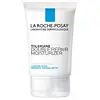What's inside
What's inside
 Key Ingredients
Key Ingredients

 Benefits
Benefits

 Concerns
Concerns

 Ingredients Side-by-side
Ingredients Side-by-side

Water
Skin ConditioningGlycerin
HumectantCyclopentasiloxane
EmollientCetyl Alcohol
EmollientStearyl Alcohol
EmollientSucrose Cocoate
EmulsifyingIsododecane
EmollientIsohexadecane
EmollientCyclohexasiloxane
EmollientGlyceryl Stearate
EmollientPEG-100 Stearate
Microcrystalline Cellulose
AbsorbentSodium PCA
HumectantPhytosteryl Isostearate
Skin ConditioningAllantoin Glycyrrhetinic Acid
Skin ProtectingTocopheryl Acetate
AntioxidantCeramide NP
Skin ConditioningPolysilicone-11
Hydrolyzed Caesalpinia Spinosa Gum
AbsorbentCaesalpinia Spinosa Gum
Skin ConditioningLinoleic Acid
CleansingLinolenic Acid
CleansingTocopherol
AntioxidantPanicum Miliaceum Seed Extract
Skin ConditioningBisabolol
MaskingSodium Hyaluronate
HumectantButylene Glycol
HumectantCamellia Oleifera Leaf Extract
AstringentMagnesium Ascorbyl Phosphate
AntioxidantSuperoxide Dismutase
AntioxidantCetyl Hydroxyethylcellulose
Emulsion StabilisingCellulose Gum
Emulsion StabilisingHydroxyacetophenone
AntioxidantDisodium EDTA
Ethylhexylglycerin
Skin ConditioningPhenoxyethanol
PreservativeWater, Glycerin, Cyclopentasiloxane, Cetyl Alcohol, Stearyl Alcohol, Sucrose Cocoate, Isododecane, Isohexadecane, Cyclohexasiloxane, Glyceryl Stearate, PEG-100 Stearate, Microcrystalline Cellulose, Sodium PCA, Phytosteryl Isostearate, Allantoin Glycyrrhetinic Acid, Tocopheryl Acetate, Ceramide NP, Polysilicone-11, Hydrolyzed Caesalpinia Spinosa Gum, Caesalpinia Spinosa Gum, Linoleic Acid, Linolenic Acid, Tocopherol, Panicum Miliaceum Seed Extract, Bisabolol, Sodium Hyaluronate, Butylene Glycol, Camellia Oleifera Leaf Extract, Magnesium Ascorbyl Phosphate, Superoxide Dismutase, Cetyl Hydroxyethylcellulose, Cellulose Gum, Hydroxyacetophenone, Disodium EDTA, Ethylhexylglycerin, Phenoxyethanol
Water
Skin ConditioningGlycerin
HumectantSqualane
EmollientDimethicone
EmollientZea Mays Starch
AbsorbentNiacinamide
SmoothingAmmonium Polyacryloyldimethyl Taurate
Emulsion StabilisingMyristyl Myristate
EmollientStearic Acid
CleansingCeramide NP
Skin ConditioningPotassium Cetyl Phosphate
EmulsifyingGlyceryl Stearate Se
EmulsifyingSodium Hydroxide
BufferingMyristic Acid
CleansingPalmitic Acid
EmollientCapryloyl Glycine
CleansingCaprylyl Glycol
EmollientXanthan Gum
EmulsifyingWater, Glycerin, Squalane, Dimethicone, Zea Mays Starch, Niacinamide, Ammonium Polyacryloyldimethyl Taurate, Myristyl Myristate, Stearic Acid, Ceramide NP, Potassium Cetyl Phosphate, Glyceryl Stearate Se, Sodium Hydroxide, Myristic Acid, Palmitic Acid, Capryloyl Glycine, Caprylyl Glycol, Xanthan Gum
 Reviews
Reviews

Ingredients Explained
These ingredients are found in both products.
Ingredients higher up in an ingredient list are typically present in a larger amount.
Ceramide NP is a type of ceramide and formally known as ceramide 3.
Ceramides are intercellular lipids naturally found in our skin that bonds dead skin cells together to create a barrier. They are known for their ability to hold water and thus are a great ingredient for dry skin.
Ceramides are an important building block for our skin barrier. A stronger barrier helps the skin look more firm and hydrated. By bolstering the skin ceramides act as a barrier against irritating ingredients. This can help with inflammation as well.
If you would like to eat ceramides, sweet potatoes contain a small amount.
Read more about other common types of ceramides here:
Ceramide AP
Ceramide EOP
Glycerin is already naturally found in your skin. It helps moisturize and protect your skin.
A study from 2016 found glycerin to be more effective as a humectant than AHAs and hyaluronic acid.
As a humectant, it helps the skin stay hydrated by pulling moisture to your skin. The low molecular weight of glycerin allows it to pull moisture into the deeper layers of your skin.
Hydrated skin improves your skin barrier; Your skin barrier helps protect against irritants and bacteria.
Glycerin has also been found to have antimicrobial and antiviral properties. Due to these properties, glycerin is often used in wound and burn treatments.
In cosmetics, glycerin is usually derived from plants such as soybean or palm. However, it can also be sourced from animals, such as tallow or animal fat.
This ingredient is organic, colorless, odorless, and non-toxic.
Glycerin is the name for this ingredient in American English. British English uses Glycerol/Glycerine.
Learn more about GlycerinWater. It's the most common cosmetic ingredient of all. You'll usually see it at the top of ingredient lists, meaning that it makes up the largest part of the product.
So why is it so popular? Water most often acts as a solvent - this means that it helps dissolve other ingredients into the formulation.
You'll also recognize water as that liquid we all need to stay alive. If you see this, drink a glass of water. Stay hydrated!
Learn more about Water